stop start Hyundai Elantra GT 2018 Workshop Manual
[x] Cancel search | Manufacturer: HYUNDAI, Model Year: 2018, Model line: Elantra GT, Model: Hyundai Elantra GT 2018Pages: 478, PDF Size: 13.64 MB
Page 347 of 478
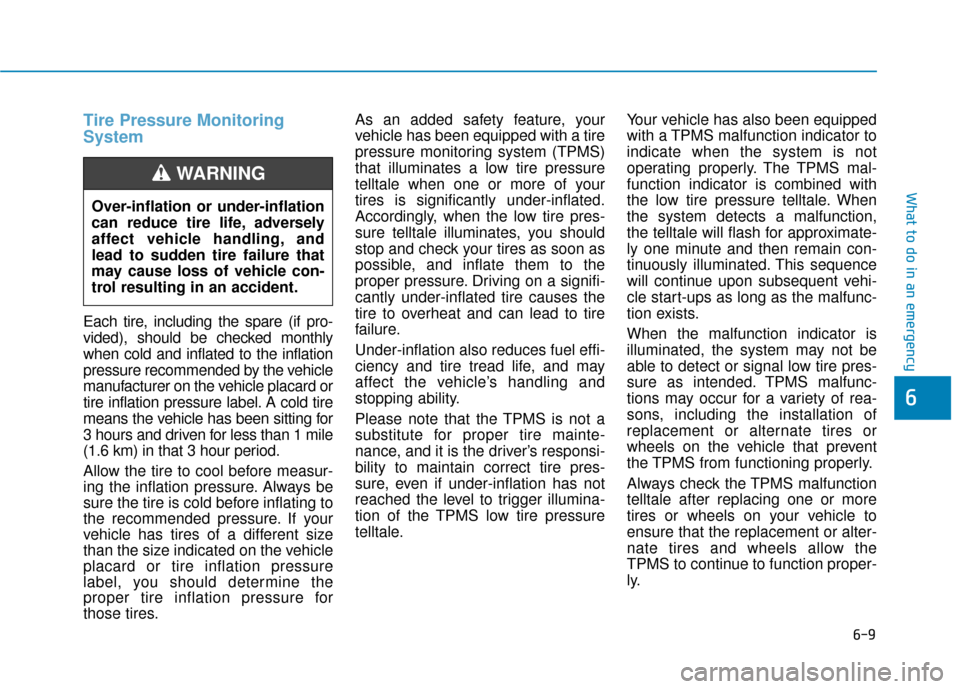
6-9
What to do in an emergency
6
Tire Pressure Monitoring
System
Each tire, including the spare (if pro-
vided), should be checked monthly
when cold and inflated to the inflation
pressure recommended by the vehicle
manufacturer on the vehicle placard or
tire inflation pressure label. A cold tire
means the vehicle has been sitting for
3 hours and driven for less than 1 mile
(1.6 km) in that 3 hour period.
Allow the tire to cool before measur-
ing the inflation pressure. Always be
sure the tire is cold before inflating to
the recommended pressure. If your
vehicle has tires of a different size
than the size indicated on the vehicle
placard or tire inflation pressure
label, you should determine the
proper tire inflation pressure for
those tires.As an added safety feature, your
vehicle has been equipped with a tire
pressure monitoring system (TPMS)
that illuminates a low tire pressure
telltale when one or more of your
tires is significantly under-inflated.
Accordingly, when the low tire pres-
sure telltale illuminates, you should
stop and check your tires as soon as
possible, and inflate them to the
proper pressure. Driving on a signifi-
cantly under-inflated tire causes the
tire to overheat and can lead to tire
failure.
Under-inflation also reduces fuel effi-
ciency and tire tread life, and may
affect the vehicle’s handling and
stopping ability.
Please note that the TPMS is not a
substitute for proper tire mainte-
nance, and it is the driver’s responsi-
bility to maintain correct tire pres-
sure, even if under-inflation has not
reached the level to trigger illumina-
tion of the TPMS low tire pressure
telltale.
Your vehicle has also been equipped
with a TPMS malfunction indicator to
indicate when the system is not
operating properly. The TPMS mal-
function indicator is combined with
the low tire pressure telltale. When
the system detects a malfunction,
the telltale will flash for approximate-
ly one minute and then remain con-
tinuously illuminated. This sequence
will continue upon subsequent vehi-
cle start-ups as long as the malfunc-
tion exists.
When the malfunction indicator is
illuminated, the system may not be
able to detect or signal low tire pres-
sure as intended. TPMS malfunc-
tions may occur for a variety of rea-
sons, including the installation of
replacement or alternate tires or
wheels on the vehicle that prevent
the TPMS from functioning properly.
Always check the TPMS malfunction
telltale after replacing one or more
tires or wheels on your vehicle to
ensure that the replacement or alter-
nate tires and wheels allow the
TPMS to continue to function proper-
ly.
Over-inflation or under-inflation
can reduce tire life, adversely
affect vehicle handling, and
lead to sudden tire failure that
may cause loss of vehicle con-
trol resulting in an accident.
WARNING
Page 381 of 478
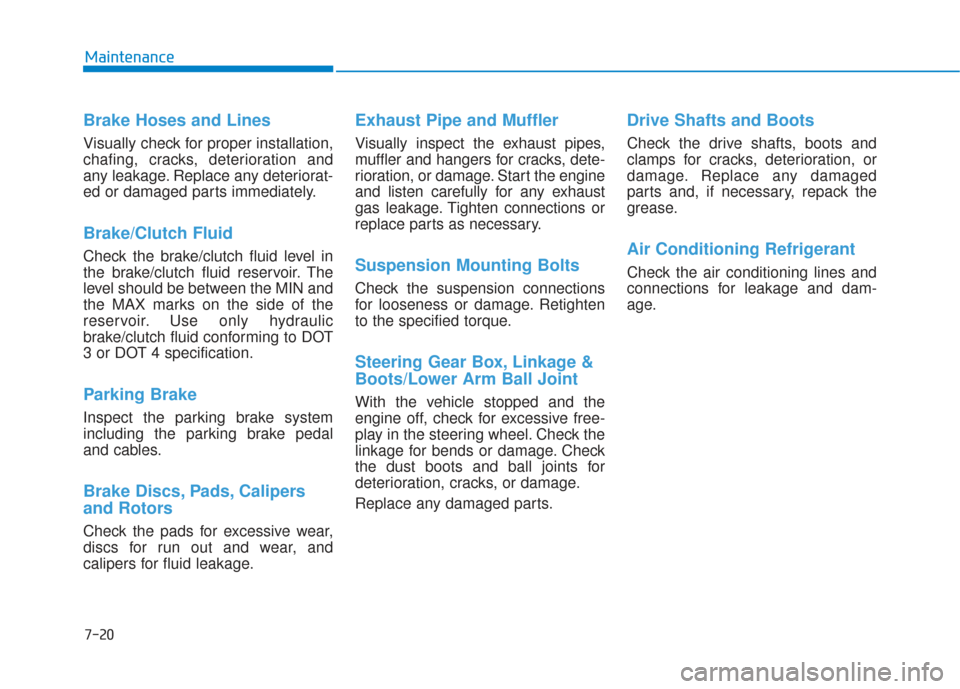
7-20
Maintenance
Brake Hoses and Lines
Visually check for proper installation,
chafing, cracks, deterioration and
any leakage. Replace any deteriorat-
ed or damaged parts immediately.
Brake/Clutch Fluid
Check the brake/clutch fluid level in
the brake/clutch fluid reservoir. The
level should be between the MIN and
the MAX marks on the side of the
reservoir. Use only hydraulic
brake/clutch fluid conforming to DOT
3 or DOT 4 specification.
Parking Brake
Inspect the parking brake system
including the parking brake pedal
and cables.
Brake Discs, Pads, Calipers
and Rotors
Check the pads for excessive wear,
discs for run out and wear, and
calipers for fluid leakage.
Exhaust Pipe and Muffler
Visually inspect the exhaust pipes,
muffler and hangers for cracks, dete-
rioration, or damage. Start the engine
and listen carefully for any exhaust
gas leakage. Tighten connections or
replace parts as necessary.
Suspension Mounting Bolts
Check the suspension connections
for looseness or damage. Retighten
to the specified torque.
Steering Gear Box, Linkage &
Boots/Lower Arm Ball Joint
With the vehicle stopped and the
engine off, check for excessive free-
play in the steering wheel. Check the
linkage for bends or damage. Check
the dust boots and ball joints for
deterioration, cracks, or damage.
Replace any damaged parts.
Drive Shafts and Boots
Check the drive shafts, boots and
clamps for cracks, deterioration, or
damage. Replace any damaged
parts and, if necessary, repack the
grease.
Air Conditioning Refrigerant
Check the air conditioning lines and
connections for leakage and dam-
age.
Page 386 of 478
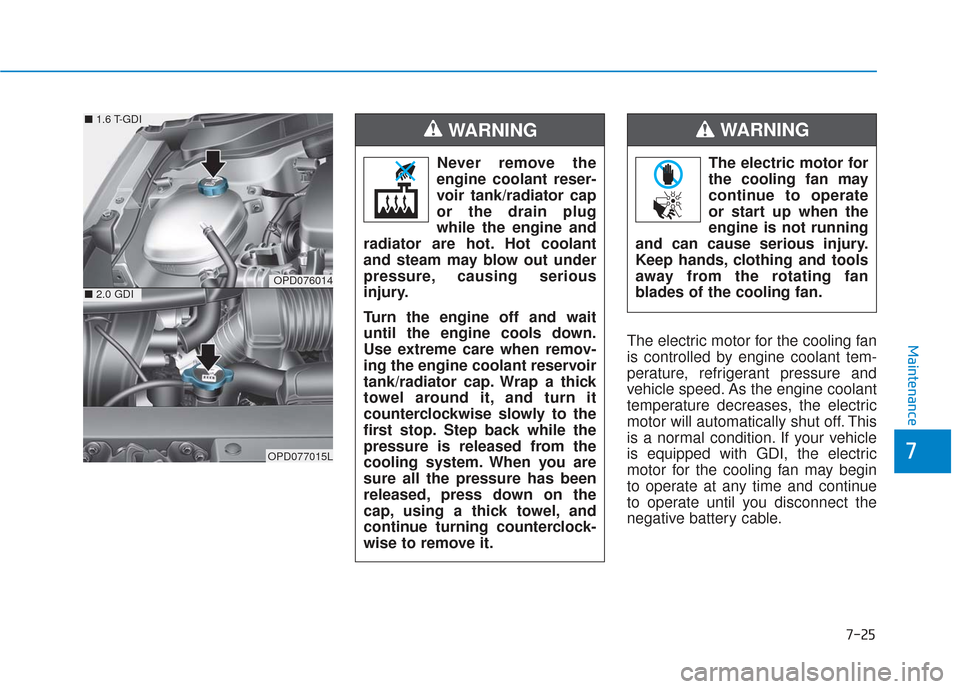
7-25
7
MaintenanceThe electric motor for the cooling fan
is controlled by engine coolant tem-
perature, refrigerant pressure and
vehicle speed. As the engine coolant
temperature decreases, the electric
motor will automatically shut off. This
is a normal condition. If your vehicle
is equipped with GDI, the electric
motor for the cooling fan may begin
to operate at any time and continue
to operate until you disconnect the
negative battery cable.The electric motor for
the cooling fan may
continue to operate
or start up when the
engine is not running
and can cause serious injury.
Keep hands, clothing and tools
away from the rotating fan
blades of the cooling fan.
WARNING
Never remove the
engine coolant reser-
voir tank/radiator cap
or the drain plug
while the engine and
radiator are hot. Hot coolant
and steam may blow out under
pressure, causing serious
injury.
Turn the engine off and wait
until the engine cools down.
Use extreme care when remov-
ing the engine coolant reservoir
tank/radiator cap. Wrap a thick
towel around it, and turn it
counterclockwise slowly to the
first stop. Step back while the
pressure is released from the
cooling system. When you are
sure all the pressure has been
released, press down on the
cap, using a thick towel, and
continue turning counterclock-
wise to remove it.
WARNING
OPD076014
OPD077015L
■ 1.6 T-GDI
■2.0 GDI
Page 396 of 478
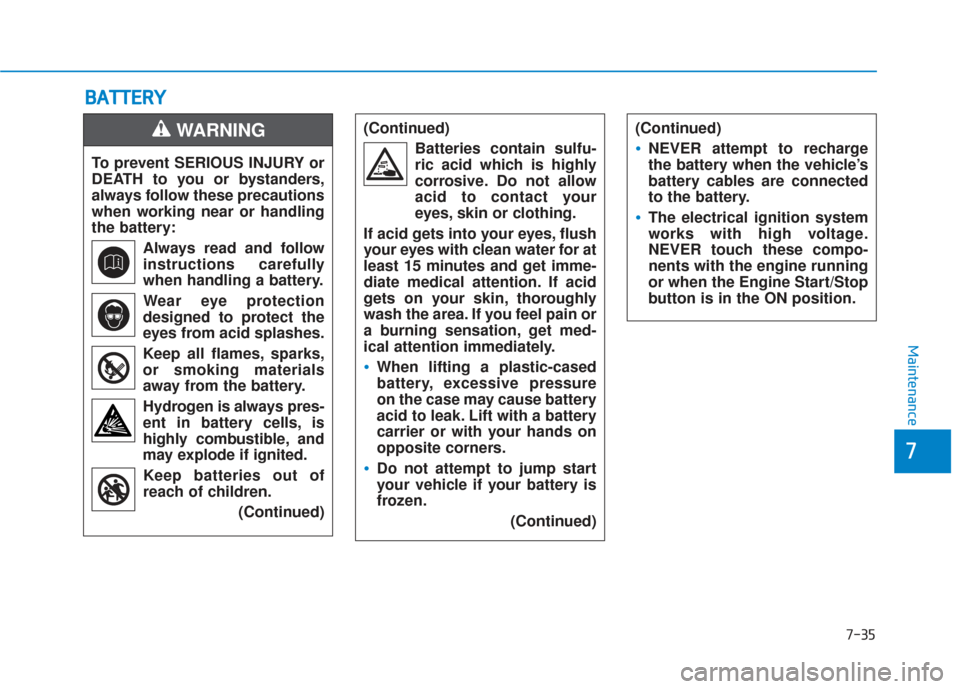
7-35
7
Maintenance
B
BA
A T
TT
TE
ER
R Y
Y
To prevent SERIOUS INJURY or
DEATH to you or bystanders,
always follow these precautions
when working near or handling
the battery:
Always read and follow
instructions carefully
when handling a battery.Wear eye protection
designed to protect the
eyes from acid splashes.
Keep all flames, sparks,
or smoking materials
away from the battery.
Hydrogen is always pres- ent in battery cells, is
highly combustible, and
may explode if ignited.
Keep batteries out of
reach of children.
(Continued)
WARNING (Continued)Batteries contain sulfu-
ric acid which is highly
corrosive. Do not allow
acid to contact your
eyes, skin or clothing.
If acid gets into your eyes, flush
your eyes with clean water for at
least 15 minutes and get imme-
diate medical attention. If acid
gets on your skin, thoroughly
wash the area. If you feel pain or
a burning sensation, get med-
ical attention immediately.
When lifting a plastic-cased
battery, excessive pressure
on the case may cause battery
acid to leak. Lift with a battery
carrier or with your hands on
opposite corners.
Do not attempt to jump start
your vehicle if your battery is
frozen. (Continued)
(Continued)
NEVER attempt to recharge
the battery when the vehicle’s
battery cables are connected
to the battery.
The electrical ignition system
works with high voltage.
NEVER touch these compo-
nents with the engine running
or when the Engine Start/Stop
button is in the ON position.
Page 398 of 478
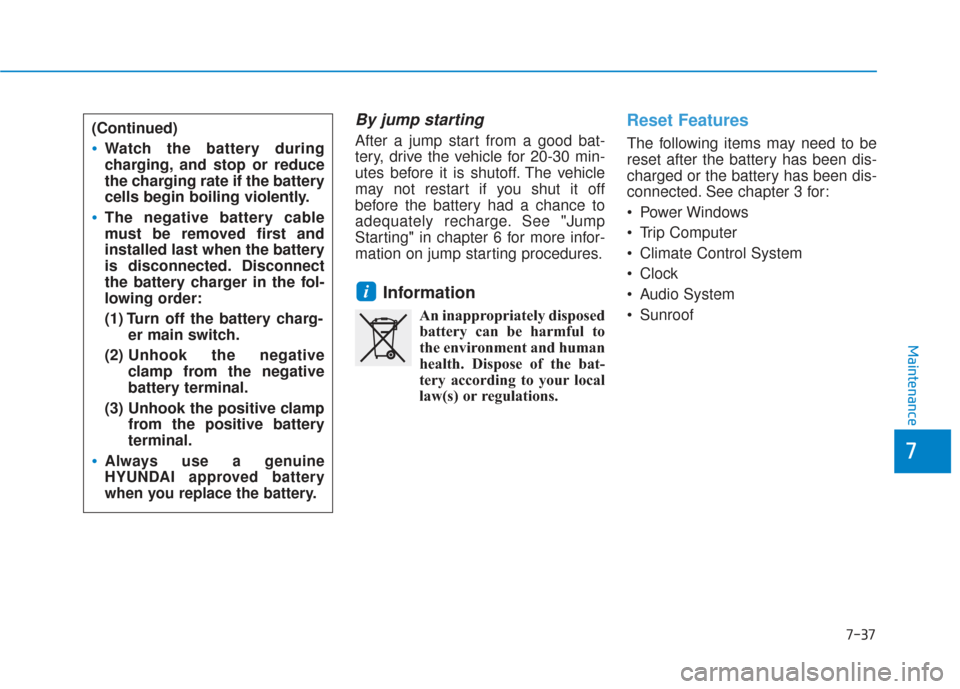
7-37
7
Maintenance
By jump starting
After a jump start from a good bat-
tery, drive the vehicle for 20-30 min-
utes before it is shutoff. The vehicle
may not restart if you shut it off
before the battery had a chance to
adequately recharge. See "Jump
Starting" in chapter 6 for more infor-
mation on jump starting procedures.
Information
An inappropriately disposedbattery can be harmful to
the environment and human
health. Dispose of the bat-
tery according to your local
law(s) or regulations.
Reset Features
The following items may need to be
reset after the battery has been dis-
charged or the battery has been dis-
connected. See chapter 3 for:
Power Windows
Trip Computer
Climate Control System
Clock
Audio System
Sunroof
i
(Continued)
Watch the battery during
charging, and stop or reduce
the charging rate if the battery
cells begin boiling violently.
The negative battery cable
must be removed first and
installed last when the battery
is disconnected. Disconnect
the battery charger in the fol-
lowing order:
(1) Turn off the battery charg- er main switch.
(2) Unhook the negative
clamp from the negative
battery terminal.
(3) Unhook the positive clamp from the positive battery
terminal.
Always use a genuine
HYUNDAI approved battery
when you replace the battery.
Page 420 of 478
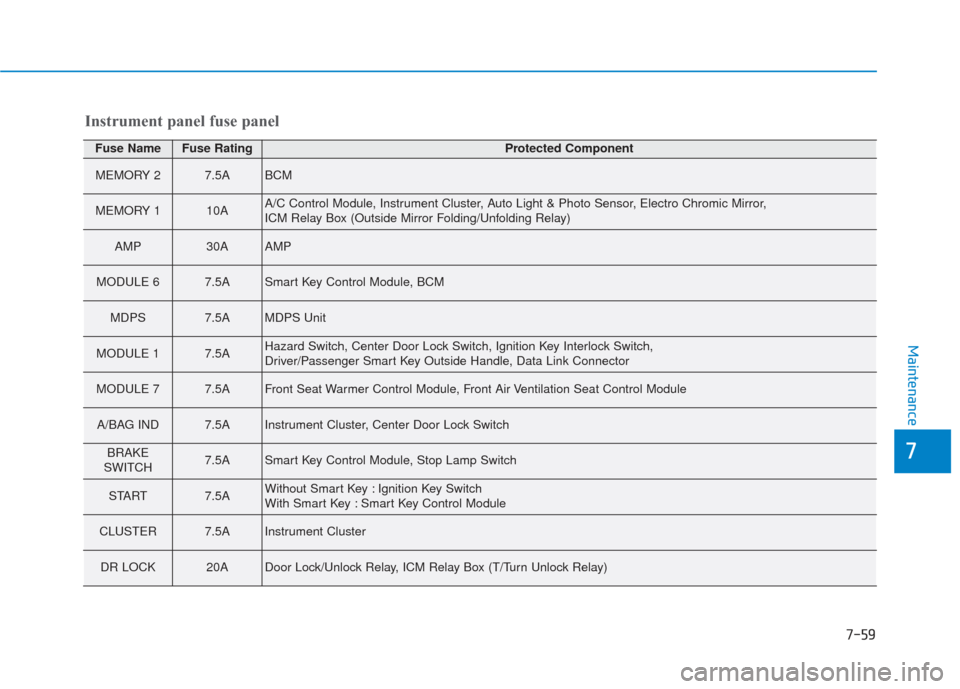
7-59
7
Maintenance
Fuse NameFuse RatingProtected Component
MEMORY 27.5ABCM
MEMORY 110AA/C Control Module, Instrument Cluster, Auto Light & Photo Sensor, Electro Chromic Mirror,
ICM Relay Box (Outside Mirror Folding/Unfolding Relay)
AMP30AAMP
MODULE 6 7.5ASmart Key Control Module, BCM
MDPS7.5AMDPS Unit
MODULE 17.5AHazard Switch, Center Door Lock Switch, Ignition Key Interlock Switch,
Driver/Passenger Smart Key Outside Handle, Data Link Connector
MODULE 77.5AFront Seat Warmer Control Module, Front Air Ventilation Seat Control Module
A/BAG IND7.5AInstrument Cluster, Center Door Lock Switch
BRAKE
SWITCH7.5ASmart Key Control Module, Stop Lamp Switch
START7.5AWithout Smart Key : Ignition Key Switch
With Smart Key : Smart Key Control Module
CLUSTER7.5AInstrument Cluster
DR LOCK20ADoor Lock/Unlock Relay, ICM Relay Box (T/Turn Unlock Relay)
Instrument panel fuse panel
Page 448 of 478
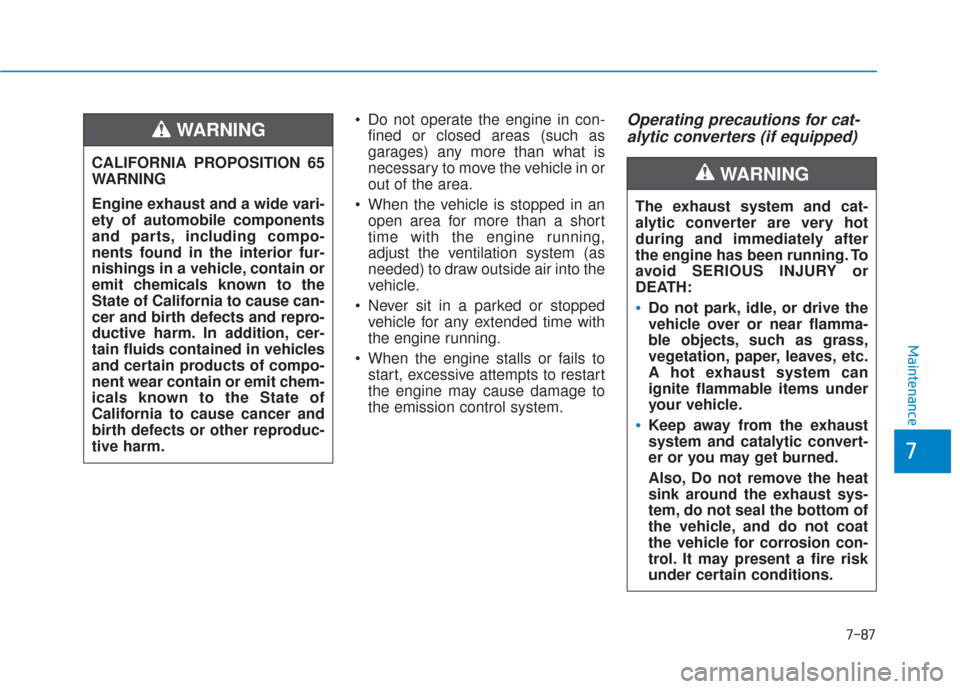
7-87
7
Maintenance
Do not operate the engine in con-fined or closed areas (such as
garages) any more than what is
necessary to move the vehicle in or
out of the area.
When the vehicle is stopped in an open area for more than a short
time with the engine running,
adjust the ventilation system (as
needed) to draw outside air into the
vehicle.
Never sit in a parked or stopped vehicle for any extended time with
the engine running.
When the engine stalls or fails to start, excessive attempts to restart
the engine may cause damage to
the emission control system.Operating precautions for cat-alytic converters (if equipped)
The exhaust system and cat-
alytic converter are very hot
during and immediately after
the engine has been running. To
avoid SERIOUS INJURY or
DEATH:
Do not park, idle, or drive the
vehicle over or near flamma-
ble objects, such as grass,
vegetation, paper, leaves, etc.
A hot exhaust system can
ignite flammable items under
your vehicle.
Keep away from the exhaust
system and catalytic convert-
er or you may get burned.
Also, Do not remove the heat
sink around the exhaust sys-
tem, do not seal the bottom of
the vehicle, and do not coat
the vehicle for corrosion con-
trol. It may present a fire risk
under certain conditions.
WARNING CALIFORNIA PROPOSITION 65
WARNING
Engine exhaust and a wide vari-
ety of automobile components
and parts, including compo-
nents found in the interior fur-
nishings in a vehicle, contain or
emit chemicals known to the
State of California to cause can-
cer and birth defects and repro-
ductive harm. In addition, cer-
tain fluids contained in vehicles
and certain products of compo-
nent wear contain or emit chem-
icals known to the State of
California to cause cancer and
birth defects or other reproduc-
tive harm.
WARNING
Page 466 of 478
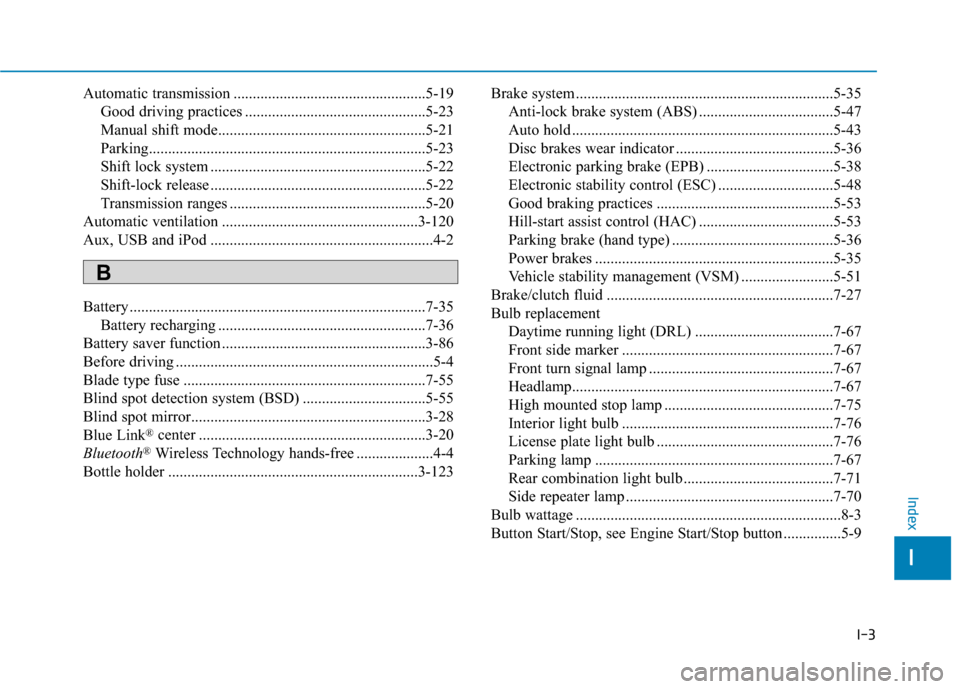
I-3
Automatic transmission ..................................................5-19Good driving practices ...............................................5-23
Manual shift mode......................................................5-21
Parking........................................................................\
5-23
Shift lock system ........................................................5-22
Shift-lock release ........................................................5-22
Transmission ranges ...................................................5-20
Automatic ventilation ...................................................3-120
Aux, USB and iPod ..........................................................4-2
Battery ........................................................................\
.....7-35 Battery recharging ......................................................7-36
Battery saver function .....................................................3-86
Before driving ...................................................................5-4
Blade type fuse ...............................................................7-55
Blind spot detection system (BSD) ................................5-55
Blind spot mirror.............................................................3-28
Blue Link
®center ...........................................................3-20
Bluetooth®Wireless Technology hands-free ....................4-4
Bottle holder .................................................................3-123 Brake system ...................................................................5-35
Anti-lock brake system (ABS) ...................................5-47
Auto hold ....................................................................5-43\
Disc brakes wear indicator .........................................5-36
Electronic parking brake (EPB) .................................5-38
Electronic stability control (ESC) ..............................5-48
Good braking practices ..............................................5-53
Hill-start assist control (HAC) ...................................5-53
Parking brake (hand type) ..........................................5-36
Power brakes ..............................................................5-35
Vehicle stability management (VSM) ........................5-51
Brake/clutch fluid ...........................................................7-27
Bulb replacement Daytime running light (DRL) ....................................7-67
Front side marker .......................................................7-67
Front turn signal lamp ................................................7-67
Headlamp....................................................................7-67\
High mounted stop lamp ............................................7-75
Interior light bulb .......................................................7-76
License plate light bulb ..............................................7-76
Parking lamp ..............................................................7-67
Rear combination light bulb .......................................7-71
Side repeater lamp ......................................................7-70
Bulb wattage .....................................................................8-3\
Button Start/Stop, see Engine Start/Stop button ...............5-9
I
Index
B
Page 468 of 478
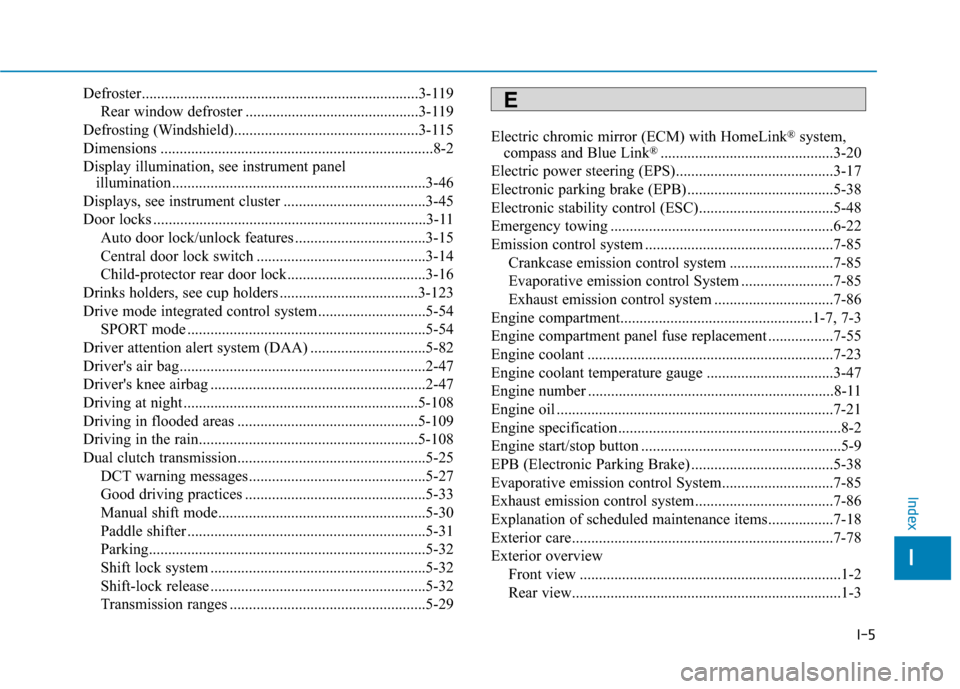
I-5
Defroster........................................................................\
3-119Rear window defroster .............................................3-119
Defrosting (Windshield)................................................3-115
Dimensions .......................................................................8\
-2
Display illumination, see instrument panel illumination..................................................................3-46
Displays, see instrument cluster .....................................3-45
Door locks .......................................................................3\
-11 Auto door lock/unlock features ..................................3-15
Central door lock switch ............................................3-14
Child-protector rear door lock....................................3-16
Drinks holders, see cup holders ....................................3-123
Drive mode integrated control system ............................5-54 SPORT mode ..............................................................5-54
Driver attention alert system (DAA) ..............................5-82
Driver's air bag................................................................2-47
Driver's knee airbag ........................................................2-47
Driving at night .............................................................5-108
Driving in flooded areas ...............................................5-109
Driving in the rain.........................................................5-108
Dual clutch transmission.................................................5-25 DCT warning messages..............................................5-27
Good driving practices ...............................................5-33
Manual shift mode......................................................5-30
Paddle shifter ..............................................................5-31
Parking........................................................................\
5-32
Shift lock system ........................................................5-32
Shift-lock release ........................................................5-32
Transmission ranges ...................................................5-29 Electric chromic mirror (ECM) with HomeLink
®system,
compass and Blue Link®.............................................3-20
Electric power steering (EPS).........................................3-17
Electronic parking brake (EPB) ......................................5-38
Electronic stability control (ESC)...................................5-48
Emergency towing ..........................................................6-22
Emission control system .................................................7-85 Crankcase emission control system ...........................7-85
Evaporative emission control System ........................7-85
Exhaust emission control system ...............................7-86
Engine compartment..................................................1-7, 7-3
Engine compartment panel fuse replacement .................7-55
Engine coolant ................................................................7-23
Engine coolant temperature gauge .................................3-47
Engine number ................................................................8-11
Engine oil ........................................................................\
7-21
Engine specification..........................................................8-2
Engine start/stop button ....................................................5-9
EPB (Electronic Parking Brake) .....................................5-38
Evaporative emission control System.............................7-85
Exhaust emission control system....................................7-86
Explanation of scheduled maintenance items.................7-18
Exterior care....................................................................7-78\
Exterior overview Front view ....................................................................1-2
Rear view......................................................................1-\
3
I
Index
E
Page 470 of 478
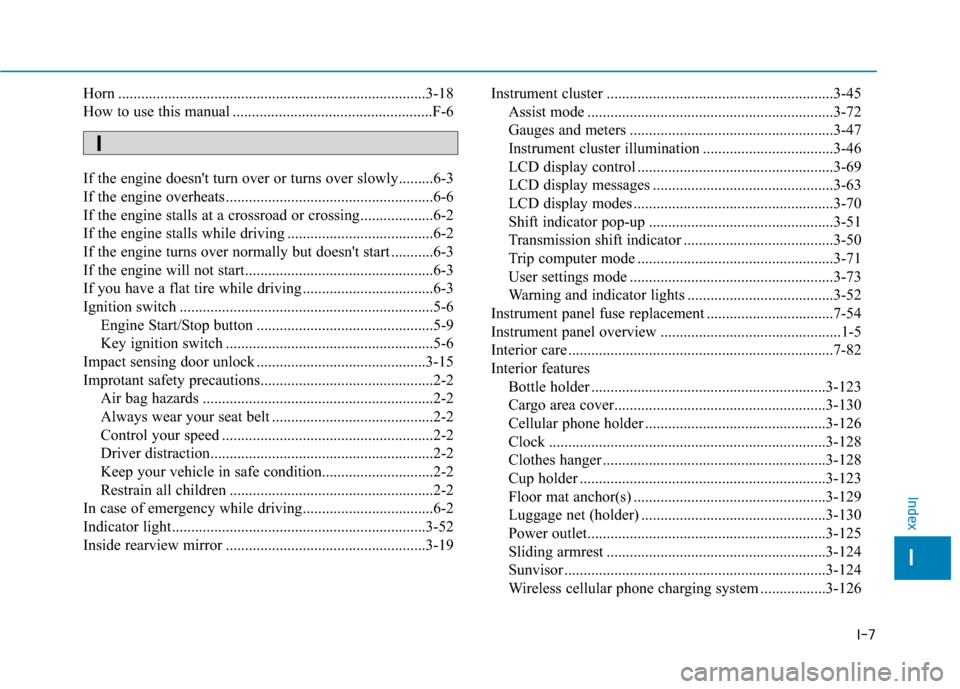
I-7
Horn ........................................................................\
........3-18
How to use this manual ....................................................F-6
If the engine doesn't turn over or turns over slowly.........6-3
If the engine overheats ......................................................6-6
If the engine stalls at a crossroad or crossing...................6-2
If the engine stalls while driving ......................................6-2
If the engine turns over normally but doesn't start ...........6-3
If the engine will not start.................................................6-3
If you have a flat tire while driving ..................................6-3
Ignition switch ..................................................................5-6Engine Start/Stop button ..............................................5-9
Key ignition switch ......................................................5-6
Impact sensing door unlock ............................................3-15
Improtant safety precautions.............................................2-2 Air bag hazards ............................................................2-2
Always wear your seat belt ..........................................2-2
Control your speed .......................................................2-2
Driver distraction..........................................................2-2
Keep your vehicle in safe condition.............................2-2
Restrain all children .....................................................2-2
In case of emergency while driving..................................6-2
Indicator light..................................................................3-52
Inside rearview mirror ....................................................3-19 Instrument cluster ...........................................................3-45
Assist mode ................................................................3-72
Gauges and meters .....................................................3-47
Instrument cluster illumination ..................................3-46
LCD display control ...................................................3-69
LCD display messages ...............................................3-63
LCD display modes ....................................................3-70
Shift indicator pop-up ................................................3-51
Transmission shift indicator .......................................3-50
Trip computer mode ...................................................3-71
User settings mode .....................................................3-73
Warning and indicator lights ......................................3-52
Instrument panel fuse replacement .................................7-54
Instrument panel overview ...............................................1-5
Interior care .....................................................................7-8\
2
Interior features Bottle holder .............................................................3-123
Cargo area cover.......................................................3-130
Cellular phone holder ...............................................3-126
Clock ........................................................................\
3-128
Clothes hanger ..........................................................3-128
Cup holder ................................................................3-123
Floor mat anchor(s) ..................................................3-129
Luggage net (holder) ................................................3-130
Power outlet..............................................................3-125
Sliding armrest .........................................................3-124
Sunvisor ....................................................................3-12\
4
Wireless cellular phone charging system .................3-126
I
Index
I